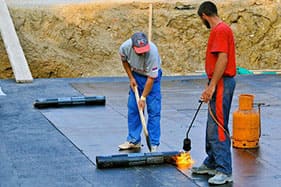Advantages of Bituminous Membrane
- Used directly underneath asphalt
- Durable
- Flexible when cold and hot
- Good weldability
- High mechanical resistance
- High puncture resistance
- High performance: with a reinforcement Glass fleece, the membrane has a perfect dimensional stability
- Dimensional stability at high temperature when pouring the asphalt
- Easy to repair tears or holes in the system
- It comes in rolls, which ease the application and keep costs down
- Manufactured in a factory which means the quality control is good
- It expands and contracts with the movement of the building
- It resists UV light, which reduces cooling costs in the summer and prolongs the life of the roof
- Offers good insulation and energy efficiency (high R-value)
- Requires minimal maintenance
- Can be applied on top of existing roof, eliminating the need for costly tear-off and disposal
Dis-advantages of Bituminous Membrane
- It can be difficult to detect the source of a leak
- It is not the longest lasting roof. Depending on the quality of the installation and the environment 10 – 15 years of service is common
- When using a hot-applied Modified Bitumen, safety is often a concern. Kettles of asphalt are dangerous.
- Bitumen roofing is also available in 1, 2, or 3-ply. The 1-ply material is not durable, and if used can pose certain problems such as breaking down prematurely, while the 2 and 3-ply material roofs cost significantly more to install, which can make this one of the most costly types of flat roofing products around.
- Granules need to be included as part of the installation process to help protect the roof from the sun. If they are not included, this can further raise the temperature of the building or damage the roof.
Lifespan of bituminous membrane

Much of this will depend on how well the material is maintained over the
years.
Although felt requires relatively low-level checks, it can still be prone to damage in
extreme weather. The local environment, footfall and how quickly any repairs are dealt with
will also be determining factors.
The durability of felt is one of its main plus points. Depending on the manufacturer, the
minimum guarantee you will receive is 10 years. However, it is commonly thought amongst
roofing experts that torch-on felt
can last beyond 30 years in many cases. Of course, this is as long as the roof is well
maintained.
How much does bituminous membrane cost?
- It’s always helpful to have a good idea of cost before you commit to a project. While felt isn’t the cheapest, it's one of the most effective systems. The prices are certainly within most people's budget.
- Roofs that feature insulation on the outside of the structure will require a vapour control layer to prevent the rise of condensation. The Torch Vapour Control Layer is a popular choice for this type of installation and isn’t prohibitively priced.
- The Torch-on felt solution relies on a three-layer system, which will require two levels of underlay underneath the cap sheet. Torch-on Underlay is a solid option, with rolls that cover 16m length, 1m width and have a thickness of 1.5mm available for a manageable outlay.
- SBS Torch-on Mineral Felt Capsheet is used as the final layer of the felt roofing process. It’s available in rolls that are 8m long and 1m wide, with a thickness of 4.2mm (Mineral) or 3.8mm (Sand). Of course, how many rolls you need will depend on the size of the roof, so ensure you measure correctly. However, even for larger projects, this is still an affordable option.
Durable when done right?

The key to getting a successful bitumen roof job done is to make sure you are having it done correctly. This means using a 2 or 3-ply material and having it coated against UV exposure. When done right, a bitumen roof can far outlast the competition.
After application, a careful inspection is required. Make sure there is no air bubble, no fold, no falling away etc to guarantee the waterproof life.

